Every moment plays an important role in learning how to swing a golf club. While you are still learning proper technique, golf can seem like a complicated game. However, among the many ways to swing, you can find your perfect golf swing. Either way, you need to know the basics of the golf swing and practice more.
The correct stance allows you to hit the ball accurately. The right grip on the golf club also plays a big part in the success of the swing. And the better the swing, the farther the ball will fly.
So, let’s take a look at how to swing a golf club correctly right now.
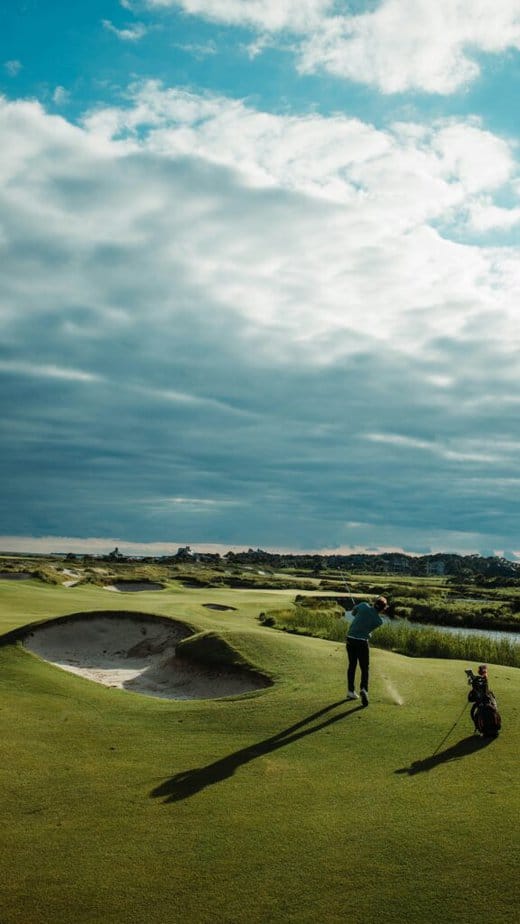
1. Stance and Ball Position
One of the main steps in understanding how to swing a golf club is knowing how to stand. Poor posture causes poor contact with the golf ball. Also, some golfers have their knees bent but their upper body remains too upright. This makes it difficult to hit the center of the ball in a circular motion around the body.
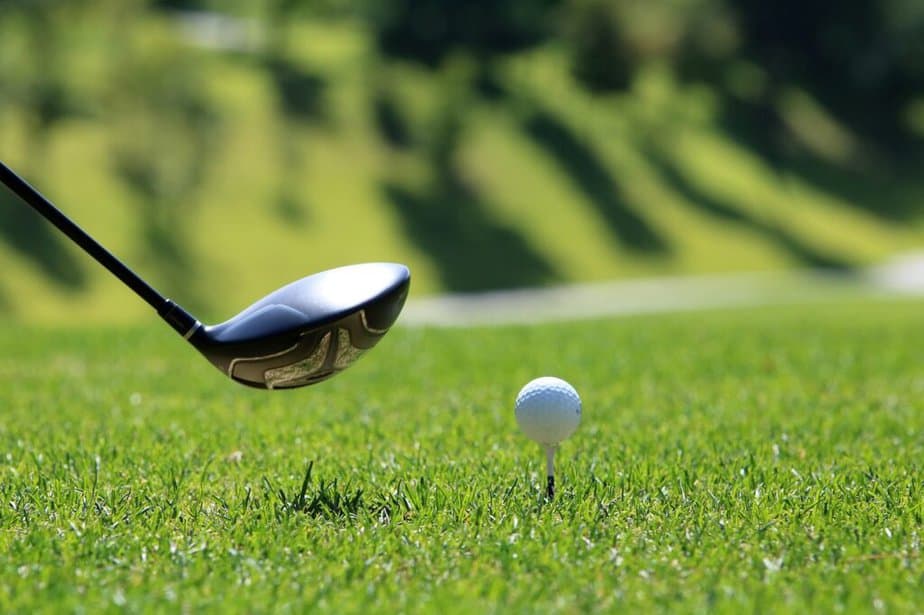
The correct stance provides a solid position throughout the swing and, therefore, better ball control.

If you follow these steps, you are sure to have a proper golf swing:
- To begin, point one side of your body toward the lawn at the hole. A right-handed golfer turns so that his left shoulder is pointing toward the hole. If you are left-handed, do the opposite. Turn your right side (right shoulder) toward the green.
- Stand correctly about the mark so that the ball is in front of your head. A position where your head is in line with or behind the ball will cause the club to touch the ground before the ball makes an impact.
- The feet should be shoulder-width apart. This stance is suitable for medium-length irons. A narrower stance is required for short irons and a wider stance for long irons. The wider the stance, the greater the amplitude of the swing. The length of the golf club therefore determines the width of the shaft.
- The toe of the foot closest to the target should be turned 2.8 inches toward the target line.
- The toe of the foot that is farther from the target should point at a point perpendicular to the target.
- Flex your knees slightly, and the upper body should be tilted forward and straight.
- Keep your posture. Keep your back straight; your head should form an angle with your spine and be behind the ball. Knees should be slightly bent, and weight should be distributed evenly between the instep of the foot and the heels. Keep your chin down and your arms free, with the right hand lower than the left (for a right-handed player).
- Your weight shifts onto the pads of your toes.
- The sole of the club should be on the ground.
- The arms should be extended, forming a wedge.
- The face of the club should form a right angle with the target, approximately from the middle to the left.
How Do You Check the Position of the Ball?
To check your position in relation to the golf ball, while holding the club, extend your arms at waist level, parallel to the ground. Then lean forward and relax your arms. The ball should lie where the club head touches the ground. If the ball is further away, you will slouch or lean forward too much. As a result of an incorrect stance, there will be numerous golf swing errors.

If the ball is in the right place at the start of the golf swing, it increases the chances of good contact and proper ball flight.
The position of the ball during preparation depends on the type of club you are using. There are the following golf ball positions:
Short irons: the ball should be placed in the center of the stance.
Long irons and 5-woods: place the ball in front of you in the center of the rack, about one ball’s distance from the center of the rack toward the target.
Long Woods, including Driver: place the ball directly in front of your right foot (right-handed). That is, about two balls from the center of the post toward the target.
Here is the ball position for each club.
2. Build A Proper Golf Grip
The correct grip in golf gives an understanding of how to swing a golf club correctly and make a full swing.
There are many different types of grip. Experiment to see which one suits you best. Over time, you will see which grip allows you to make the perfect golf swing.

Whichever grip you choose, your hands should be close together and ideally overlap. This will allow your hands to act as a unit during the swing.
Grip the golf club as naturally and relaxedly as possible. This will give you better accuracy when hitting the golf ball, as the club head can flip in the right direction when you swing. Always hold the golf club in your weak hand (left arm for right-handed golfers).
At the top of the grip, the club should protrude about half an inch.
The thumb of your left hand (for right-handed golfers) should be pointing down toward the right side of the shaft. Now take the golf club in your right hand, placing your right thumb on top of the thumb of your opposite hand. The right thumb should be on the left side of the club and pointing downward.
The face of the club should strike the ball directly with the entire plane, not at an angle that could send the ball flying sideways.
There are three basic ways to grip: lock, overlap, and baseball grip (ten-finger grip).
Lock
In the lock grip, the little finger of the right hand is intertwined with the index finger of the left hand. During the swing in the lock grip, the hands are joined together. Because this grip requires less strength than the overlap grip, it is ideal for women and players with small hands or short fingers.
Grip the club with your left hand; three joints should be visible, and your thumb should be slight to the right of the center of the grip. Then grasp the club with your right hand. The index, middle, and ring fingers should touch the handle, and the little finger of the right hand should intertwine with the index finger of the left hand.
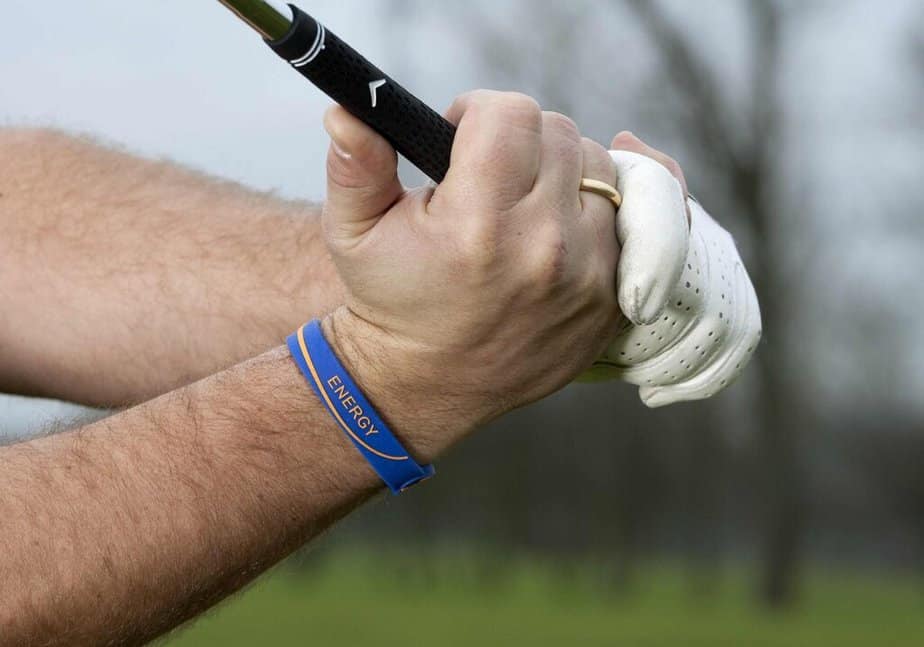
Overlap
This type of grip is also called the Vardon grip because Harry Vardon made it popular. This type of grip is mainly used by professional golfers. It requires strong hands because fewer fingers are used to control the club. Grip technique: the little finger of the right hand is placed on top between the index and middle fingers of the left hand, and the ring finger of the right hand also touches the index finger of the left hand. With this grip, you feel that your hands are connected and working together during the swing.

Baseball Grip
The ten-finger grip is also known as the baseball grip. It is suitable for players who do not have very strong hands. You hold the golf club with all your fingers, which makes the grip stronger. However, it is more difficult to control the club head.
In the baseball grip, the right-hand rests on the index finger of the left hand. Grip the club with your left hand. Place your right hand below it. All joints should form a single line with the shaft, and all fingers should be on the grip (index, middle, ring, and pinky fingers).
As you can see, the most important thing about the grip is that you must hold the club firmly enough to control it, but you must not squeeze it too tightly; otherwise, blisters will appear. If you squeeze the club too hard, blisters will probably form on the part of your hand that comes in contact with the thick end of the club. This will also create tension in your hands and arms, and your swing flexibility will be weakened.
The club, hand, and body should stay connected and turned together. Also, remember that the position of your palms and fingers should not change throughout the swing.
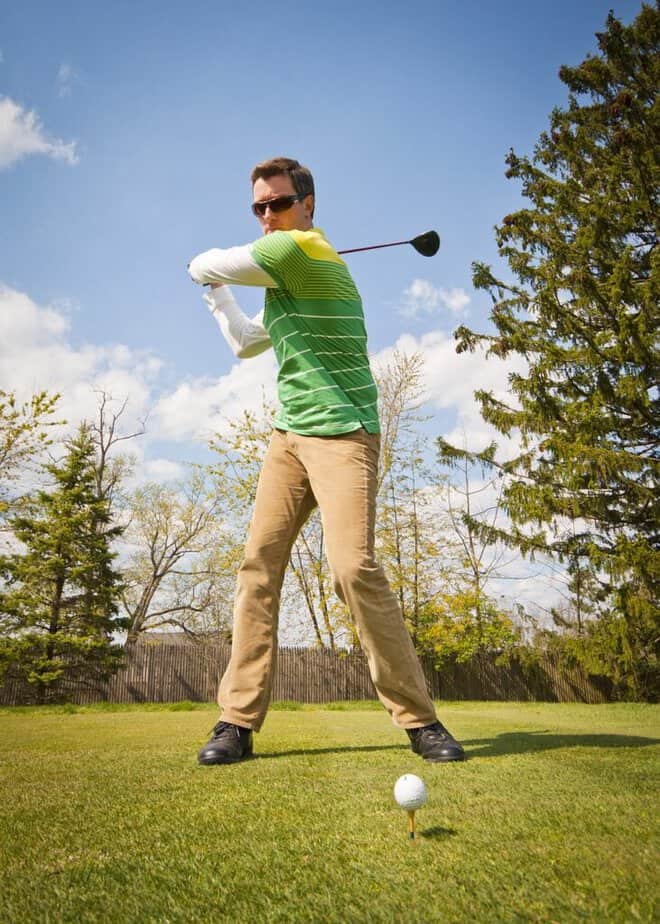
3. How to Swing a Golf Club
Moving on to the next stage, a big swing at the golf ball. The perfect golf swing requires rhythm and good balance.
The rhythm of the swing can be fast or slow, depending on your body weight and the rhythm you choose, but in any case, the swing should always be done smoothly. In a hurry, you can lose your balance.
So, when you have mastered the correct position and made the grip, it’s time to make your perfect golf swing.
The direction of the club’s face is very important for the trajectory of the ball. When you are preparing your golf shot, try to aim with the lower groove of the club face. Remember that the club is designed with the top edge pointing to the left side of the target.
Let’s break down the golf backswing and downswing in more detail
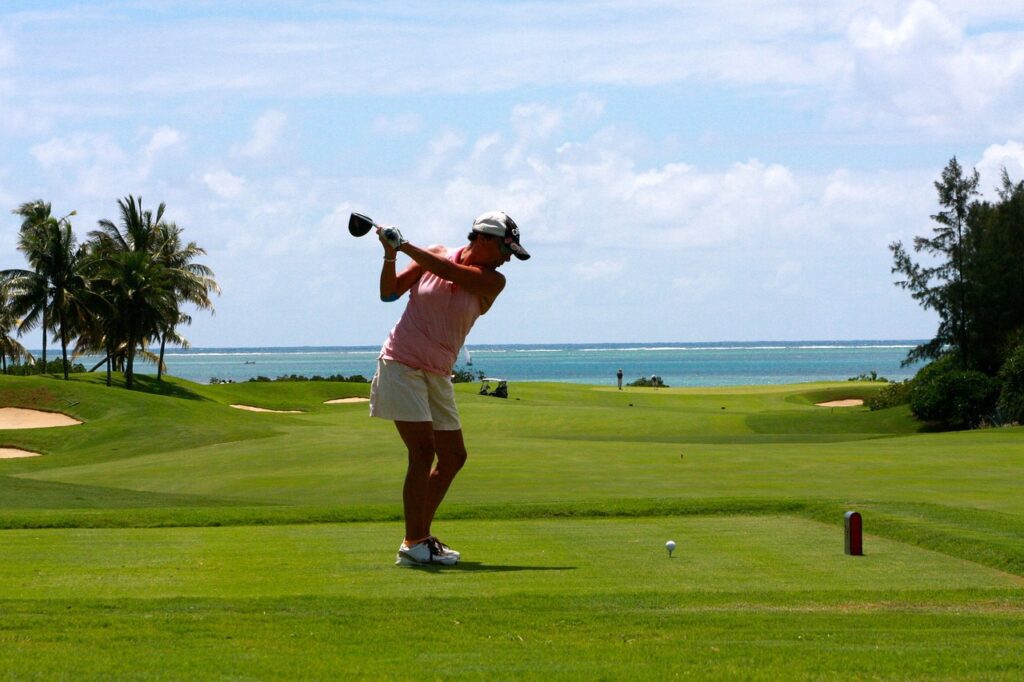
How Do I Start a Putter Swing?
When swinging, the club is lifted from the starting position and put behind the head.
Remember that the right elbow is an important part of the golf shot (and vice versa for left-handed golfers). It helps make the shot more accurate.
When swinging the club, the right elbow should be bent at a 90-degree angle. This will help you keep your swing correct and generate more power. You should not use your right arm to lift the club. Your left arm should do it.
During the downswing, keep your right elbow close to your body to keep your aim accurate. When you reach the bottom of the swing, pull your right elbow forward to generate even more power.
Try to turn your body when swinging. There are three stages to the golf swing:
Bring your arms back, keeping them closer to the foot farthest from the hole. Try to keep the arm closest to the hole straight. When the club head is at the endpoint of the swing, the club shaft should be almost parallel to the ground.
Rotate your hands slightly with your arms parallel to the ground. The club should be held strictly perpendicular to the left arm (for right-handed players). The end of the club will face slightly away from the golf ball.
Rotate the body back a little further so that the club head is slightly behind the hands at the end of the swing. The front arm should bend slightly in the final phase of the swing.
The Downward Movement of the Club
When the swing goes down, point the club head so that it is slightly behind the overall body movement; the angle between the arm and the club increases, and upon entering the strike zone, spin out quickly. This will allow you to develop high speed at the end of the club. At the same time, the body will continue to move relatively slowly and maintain control.
Before hitting the shot, try to lock the front arm again so that it is completely straight (as at the start of the swing).
Shift your weight from the foot farthest away from the hole to the foot closest to the hole. Let your knees move toward the target. Keep your front knee relaxed (especially if you are hitting a driver).
Another good way to do a correct weight transfer to the left side is to immediately move your right knee toward your left knee at the top of the swing. Think about moving your right knee across towards your left knee on the downswing.
The downswing begins with a slight lateral shift, moving the left knee and hip over the left foot.
Do not try to hit with your arms only. To increase the energy of the punch, add hip movement. At impact, the hips continue to turn so that the left hip is already loose at the time of impact. The chest is less turned, facing the ball, because the hips are pulling the shoulders behind them. Make sure your head stays behind the ball and your left side straightens as your right side moves forward.
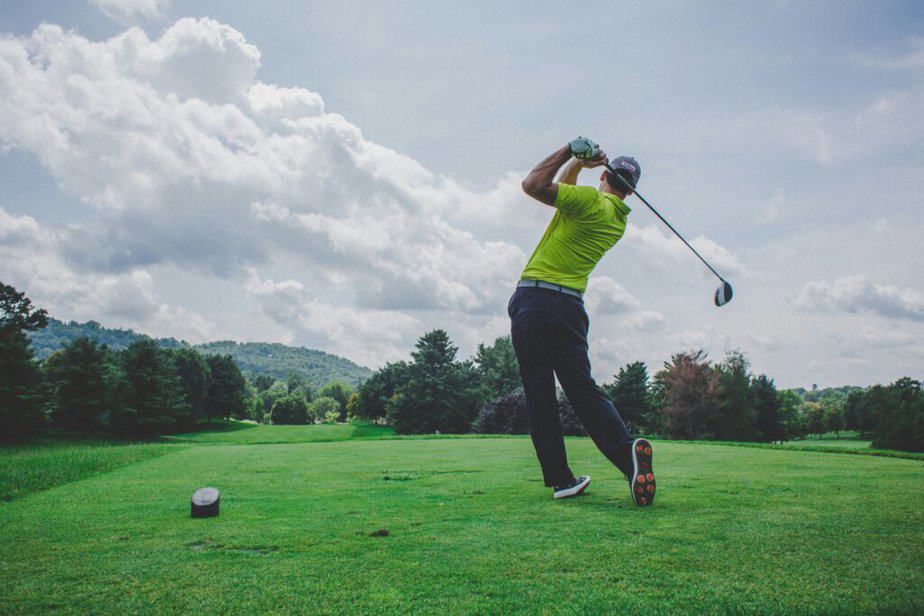
How Do I Finish the Swing?
If you have made a nice backswing, the downswing is all about unwinding into a balanced finish. Your weight should shift slightly onto your front foot at the apogee of the swing before you release it and turn to face the target line.
When performing a golf swing, keep the right side of the motion. The right side of your body is turned relative to the left, so your right shoulder is closest to the target (for right-handed golfers). With your hands behind your head, your arms are soft and bent. Your left wrist should be flat at the top, and your spine angle should resemble that at the moment of impact.
If the swing is done correctly, you should finish it in a certain position. The belt buckle will be facing the target, the club will be behind your back, the main body mass is transferred to the leg nearest to the target, and the back leg is on the toe. You should be comfortable standing in this position. And at the same time, you will be able to follow the flight of the ball.
Keep your eyes on the ball while you are swinging and hitting. Do not raise your head immediately after the shot, as this may interfere with the accuracy of your aim.
Learn more about how to play golf in this article.
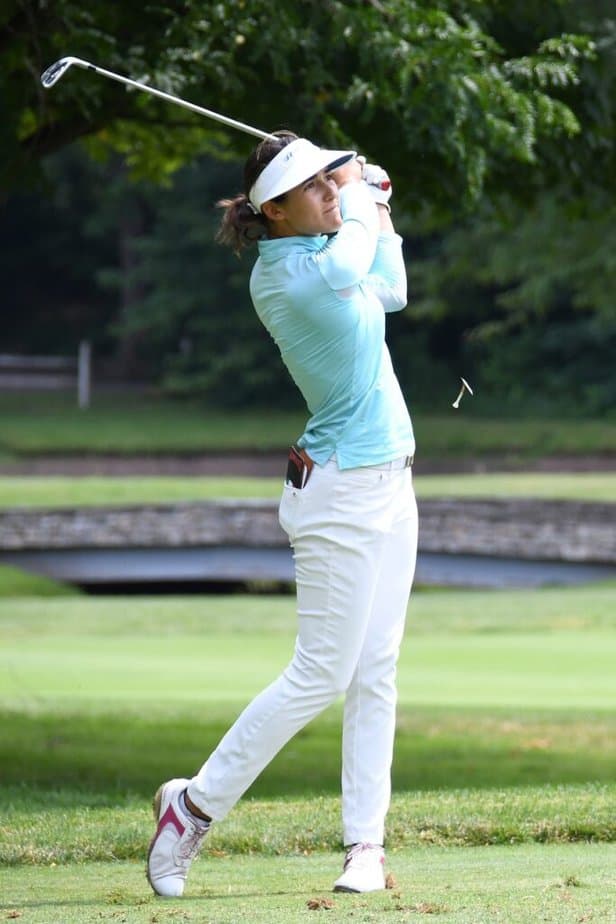
Final Word
We hope you found our guide on how to swing a golf club useful.
By following these guidelines, you will be able to practice your stance, ball position, grip, and golf swing.
And although we have offered clear criteria for how to swing a golf club, you can always find your unique swing. After all, every professional golfer has his or her own golf technique. Practice your ideal golf swing, find your technique, and share your impressions in the comments.
